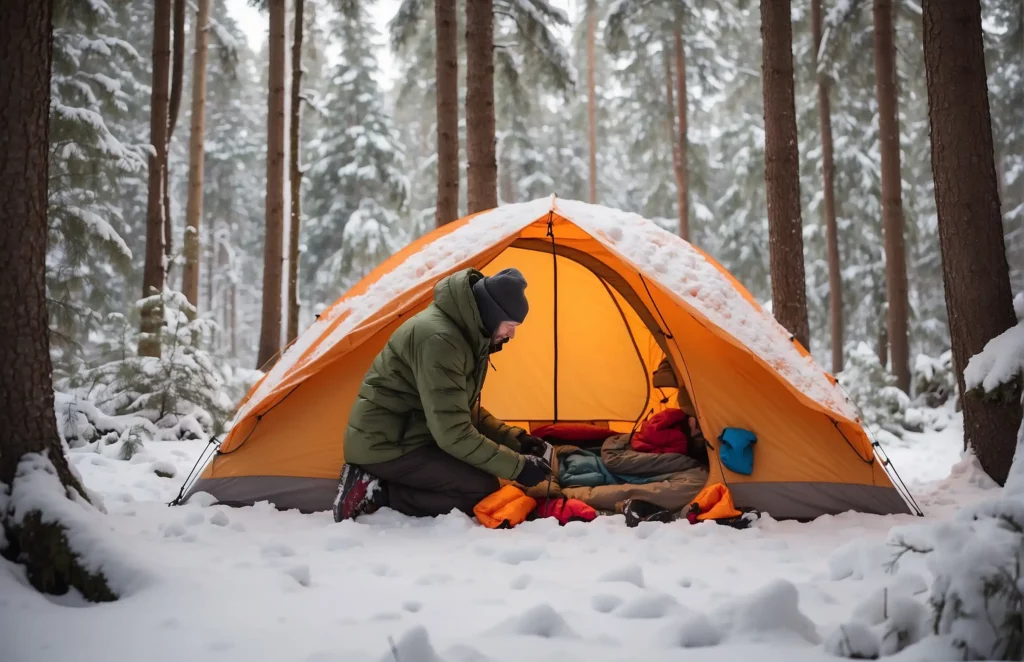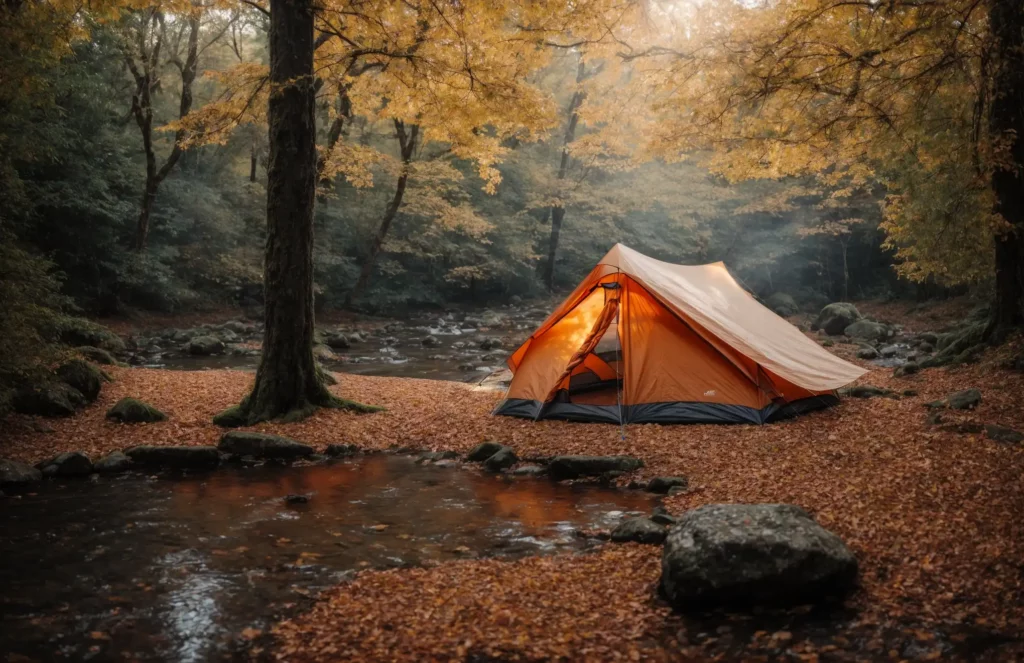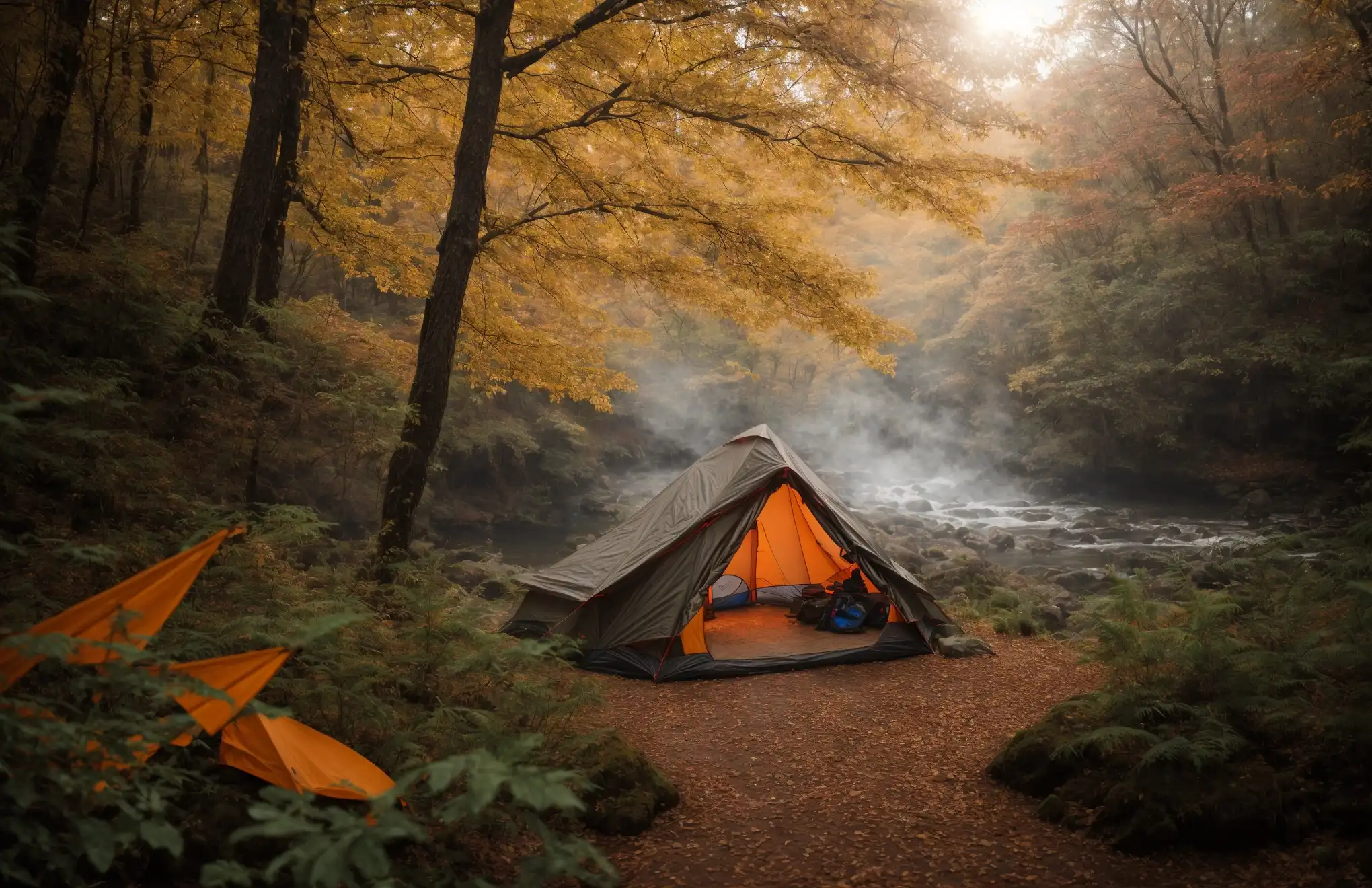Stay warm tent camping by choosing an insulated tent and wearing layered clothing. Use a quality sleeping bag and an insulated pad for added warmth.
Tent camping in cold weather doesn’t have to be uncomfortable. With the right gear and techniques, you can enjoy the great outdoors without the chill. Selecting the appropriate equipment is pivotal; opt for a four-season tent, a sleeping bag rated for low temperatures, and a sleeping pad with a high R-value for insulation from the ground.
Dress in moisture-wicking base layers, insulating mid-layers, and a windproof outer-shell to retain body heat. Heat-retention strategies, like filling a bottle with hot water to place in your sleeping bag or eating a hearty meal before bed to boost metabolism and generate warmth, are also effective. Remember, staying dry is critical, so always keep your gear and clothes protected from moisture. Plan well, and cold-weather camping can be a cozy and exhilarating experience.
Tent Camping In Cold Conditions
Tent camping during colder seasons adds an exhilarating twist to typical outdoor adventures. However, it demands knowledge, preparation, and the right gear to remain cozy and safe. Experiencing the serene beauty of a wintry landscape from the comfort of your tent is palpable with essential know-how. This section unveils critical insights for campers braving the chill to ensure an enjoyable and warm outdoor stay.

Understanding the Challenges of Cold Weather Camping
Cold weather camping introduces unique challenges that require attention for a successful trip. Not only does the body struggle to maintain its core temperature, but the environment can also present risks such as hypothermia, frostbite, and the unpredictability of winter weather. In this section, campers will learn about:
- Insulating techniques to retain body heat
- Choosing the right sleeping gear for low temperatures
- Navigating and preparing for potential weather hazards
Understanding these concerns is the first step to ensuring that your tent camping experience is not just endurable, but also delightfully warm and memorable.
Preparing Your Mindset For A Chilly Outdoors Experience
Embarking on a tent camping trip in the cold is as much about mental preparation as it is about having the right equipment. A positive and proactive mindset is your ally against the challenges posed by the cold. In this segment, learn about:
- Adopting a ‘can-do’ attitude towards the cold
- Mentally preparing for shorter days and longer nights
- Setting realistic expectations for comfort and activity levels
Equip yourself with a mind fortified against the cold, and transform a potentially daunting experience into an empowering journey through winter’s wonders.
Learn: When is the Best Time to Go Camping
Choosing the Right Tent and Sleeping Gear
Embarking on a tent camping adventure in cold weather can be invigorating and fun, but chilly nights can dampen the experience without the proper equipment. The key to a comfortable and warm tent camping experience lies in selecting the right gear. Understanding what to look for in a winter tent and sleeping assembly ensures your outdoor excursions are memorable for all the right reasons. Stay snug as a bug with the essential gear poised for cold-weather camping success.

Key Features of a Winter Tent
Choosing a winter tent is the first step in prepping for a cozy slumber under the stars. Durability, insulation, and weatherproofing are non-negotiable when it comes to a winter tent. Here’s what you should focus on:
- Double-Walled Construction: Provides extra insulation and reduces condensation.
- Sturdy Poles: Opt for quality materials capable of withstanding heavy winds and snow loads.
- Ventilation Options: Adequate vents minimize moisture inside the tent.
- Four-Season Rating: This indicates the tent is designed for year-round use, especially in harsh conditions.
- Heavy-Duty Zippers: Zippers should work smoothly even in freezing temperatures.
The Importance of a High R-value Sleeping Pad
An often overlooked component of a warm sleeping setup is the sleeping pad. Beyond providing comfort, it serves as a crucial barrier between you and the cold ground. R-Value measures the pad’s capacity to resist heat flow. In frosty settings, a high R-Value is your best friend:
| R-Value Range | Suitable Temperature |
|---|---|
| 4.0 – 6.0+ | Winter and Four-Season Camping |
| 2.0 – 4.0 | Cool to Cold Weather Camping |
| Less than 2.0 | Warm Weather Camping |
Select closed-cell foam pads or insulated air pads with high R-Values to ensure a warm and comfortable sleep.
Selecting the Right Sleeping Bag For Temperature Ratings
Your sleeping bag is your ultimate shield against the elements. Pay close attention to the temperature ratings to choose a bag that matches the climate. Consider the lowest temperatures you expect to encounter and then get a sleeping bag rated slightly lower for added security.
- Check the EN/ISO Rating: This European Standard provides reliable temperature ratings for sleeping bags.
- Down vs. Synthetic: Down bags are lighter and more compressible but lose insulating power when wet. Synthetics are bulkier but insulate even when damp.
- Draft Collars: These insulated tubes around the neck prevent heat from escaping.
- Mummy Shape: This design minimizes air pockets, trapping heat more efficiently.
Combine a correctly rated sleeping bag with an appropriate sleeping pad and a robust winter tent, and you have the perfect trio to keep the cold at bay.
Layering Strategies For Body Heat Retention
Staying snug as a bug inside your tent on a cold night is all about mastering the art of layering. Properly layering your clothes traps body heat, creating a personal cocoon of warmth. Let’s dive into the strategies to ensure cold weather doesn’t put a damper on your outdoor adventure.
Understanding the Layering System
The layering system is your best defense against the chill. Think of it as your personal climate control strategy tailored to the outside environment. Adopting this system means wearing multiple layers, each serving a unique purpose: moisture management, insulation, and weather protection.
- Base Layer: This layer sits directly on your skin, with the goal of keeping you dry by wicking sweat away.
- Mid Layer: The main insulating layer retains body heat to keep you warm.
- Outer Layer: The shield against the elements—wind, rain, and snow.
Materials and Fabrics Best Suited For Cold Weather
Selecting the right materials is critical for warmth and comfort. High-quality fabrics lock in warmth and expel moisture. Here’s a breakdown of fabrics to consider:
| Fabric | Properties | Use |
|---|---|---|
| Merino Wool | Warm, breathable, odor-resistant | Base Layer |
| Fleece | Lightweight, warm, breathable | Mid Layer |
| Synthetic Insulation | Quick-drying, effective even when wet | Mid Layer |
| Gore-Tex | Waterproof, windproof, breathable | Outer Layer |
Balancing Layering and Ventilation to Avoid Sweating
Sweat is the enemy of staying warm while camping. Even in cold weather, too many layers can lead to perspiration, ultimately making you feel colder once activity levels drop. The key is to balance layering with ventilation. Open zippers and venting features on your outer layer aid in managing this delicate equilibrium. Remove layers as you become more active to avoid sweat build-up, and add them back during periods of rest. Aim for a comfortable, consistent body temperature.
Utilizing Heating Sources Safely and Effectively
As the night falls and the campfire dims, the chill of the outdoors becomes more apparent. Staying warm in a tent is about more than just piling on the blankets; it’s about harnessing the right heating sources safely and effectively. This section dives into the various methods of tent heating, ensuring warmth through the coldest nights without sacrificing safety.
Pros and Cons Of Portable Heaters In Tents
Portable heaters can be a game-changer for tent camping in cooler climates. However, they come with their own set of considerations. Let’s explore these:
| Pros | Cons |
|---|---|
| Efficient heat distribution | Risks of carbon monoxide poisoning |
| Variety of fuel options | Must carry fuel or batteries |
| Adjustable temperature settings | Ventilation requirements |
| Quickly heats the space | Potential fire hazard if not used correctly |
Safe Practices For Using Heat Packs
When it comes to non-electric warmth, heat packs are a popular choice. To use these safely:
- Avoid direct skin contact to prevent burns.
- Ensure heat packs are properly sealed to prevent chemical leakage.
- Do not place heat packs near flammable materials.
- Follow the manufacturer’s instructions to activate them correctly.
With vigilance, heat packs provide a convenient and portable source of warmth that can significantly enhance the comfort of your tent.
The Do’s and Don’ts of Tent Heating
Maintaining warmth in your tent is crucial, but so is safety. Here are some essential tips:
Do: Choose the right size heater for your tent.
Keep the heater away from the tent walls and any flammable materials.
Ensure adequate ventilation to prevent condensation and carbon monoxide buildup.
Don’t: Leave heaters unattended or running while you sleep.
Use gas heaters in an enclosed space without a carbon monoxide detector.
Block the tent’s entrances or exits with heating equipment.
By adhering to these guidelines, you can achieve a cozy and secure tent atmosphere, no matter how low the temperature drops outside.
Additional Tips and Tricks For Staying Warm
While a good sleeping bag and an insulated tent are key to a cozy night in the wilderness, there are other clever ways to retain heat that can make all the difference. Let’s dive into some additional strategies to ensure you stay warm and comfortable throughout the night, no matter how low the mercury drops.
Hot Water Bottles and Hand Warmers
Hot water bottles prove their worth when the temperature falls. Here’s how to use them efficiently:
- Fill a durable water bottle with hot water before bedtime.
- Wrap it in a cloth to prevent burns and place it in your sleeping bag.
- Position it near high heat-loss areas such as the abdomen or feet for optimal warmth.
Similarly, hand warmers are compact heat sources you can activate and tuck into gloves, pockets, or your sleeping bag. They are excellent for quick, localized warmth and can easily be replaced as needed.
Nutrition and Hydration to Maintain Body Heat
Eating the right foods and staying hydrated play a crucial role in maintaining body temperature:
| What to Consume | Benefits |
|---|---|
| Complex Carbohydrates | Slow-burning energy helps keep your internal furnace lit. |
| Fats | Caloric density provides sustained heat generation. |
| Warm fluids | Hot drinks can elevate core temperature and provide comfort. |
Staying Dry to Preserve Warmth
The importance of staying dry to conserve body heat cannot be overstated. Wet clothing or gear can lead to a rapid loss of warmth. Follow these steps:
- Always change into dry clothes before entering your sleeping bag.
- Hang any damp items inside the tent to benefit from your body heat or under the rainfly to dry overnight.
- Use a highly absorbent towel to remove moisture from the inside of your tent and from your gear.
Conclusion
Embracing the chill of nature doesn’t mean sacrificing comfort. Master the art of cozy tent camping with these tips. Layer up, fuel up, and insulate your tent for the ultimate warm retreat under the stars. Don’t let the cold deter your adventure spirit; stay toasty and relish the great outdoors.
For those who seek more than just trails, our Learning category at Outdoor Awaits offers a treasure trove of outdoor insights.
Sukhen is a passionate blogger and traveler who visited many historical places in Bangladesh, Myanmar, India, and Thailand. He's an avid camper, so he shares his knowledge of camping and wildlife with his readers. He also helps readers plan their own camping trips. To know more, stay connected with Outdoor Awaits.

